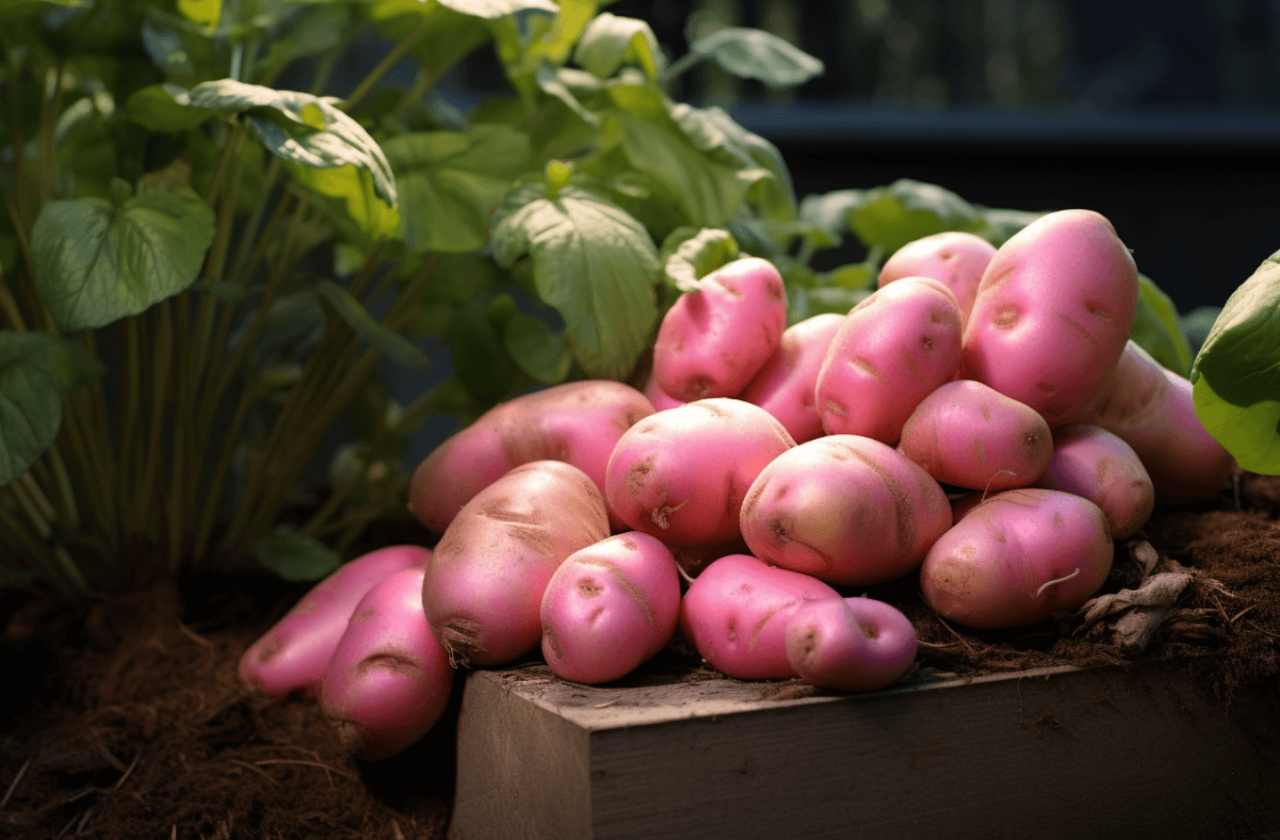Pink Fir Potatoes: A Delicate Delight in the Garden

Introduction
Pink Fir potatoes are a beloved and visually striking variety that adds a touch of elegance to your culinary creations. With its delicate pink skin and waxy yellow texture, Pink Fir stands out as a favourite among gardeners and food enthusiasts alike, being especially great as salad potatoes.
In this comprehensive guide, we’ll delve into the background of this variety, share essential tips for growing them, and answer frequently asked questions, so you can experience the culinary delight of these unique spuds in your very own garden.
Background and Origins
Pink Fir potatoes, also known as Pink Fir Apple potatoes, have a rich history that dates back to the 19th century in France. Originating from South America, these fingerling potatoes were introduced to Europe and quickly became renowned for their nutty flavour and captivating appearance. The name “Fir Apple” refers to the potato’s elongated and knobbly shape, resembling a pinecone. Pink Fir’s stunning pinkish skin and waxy flesh make it a standout addition to any gourmet dish.
Growing Pink Fir Potatoes
1. Soil and Sunlight
The potatoes love well-draining, fertile soil enriched with organic matter such as rotted manure. They thrive in full sun but can tolerate partial shade, they can also be grown successfully in potato grow bags.
2. Planting
Start planting seed potatoes in early spring (after chitting), a few weeks before the last expected frost. Choose certified seed potatoes with healthy sprouts. Plant them about 4 inches deep and 10-12 inches apart in rows with 2-3 feet spacing.
3. Watering
Keep the soil consistently moist, especially during dry spells, to support tuber development. Avoid overwatering to prevent waterlogging, which can lead to rot.
4. Hilling
Once the plants reach around 6 inches in height, gently cover with soil around the stems to encourage additional tuber growth and protect the developing potatoes from exposure to sunlight as this will turn the tubers green and render them inedible.
5. Pest and Disease Control
Watch for common potato pests like Colorado potato beetles and potato aphids. Employ natural pest control methods and consider introducing beneficial insects to keep pest populations in check. Practice crop rotation to minimize disease issues.
6. Harvesting
The potato tubers are ready for harvest when their foliage has died back and turned yellow. Carefully dig them up with a garden fork to avoid damaging the tender tubers and enjoy them hot or cold (but always cook first as with all potatoes).
Frequently Asked Questions about Pink Fir Potatoes
Q: Can I eat the skin of Pink Fir potatoes?
A: Yes, absolutely! The delicate pink skin of the tubers is entirely edible and adds a unique touch to your dishes. It’s best to give them a gentle scrub to remove any dirt before cooking.
Q: What culinary uses are best for Pink Fir potatoes?
A: They shine in salads, roasted dishes, and as an eye-catching side dish. Their waxy texture holds up well during cooking, making them ideal for salads and boiled preparations.
Q: When to plant Pink Fir apple potatoes?
A: This variety is maincrop and is ideally planted in early spring, a few weeks before the last expected frost. This allows them to establish strong roots and thrive in the warmer months.
Q: When are Pink Fir potatoes ready to harvest?
A: Pink Fir potatoes are typically ready for harvest approximately 90 to 120 days after planting. You can begin harvesting baby potatoes earlier, around 70 to 80 days, for a tender and delicious treat.
Q: How to store Pink Fir apple potatoes?
A: To store the potatoes and maintain their freshness, keep them in a cool, dark, and well-ventilated place. A pantry, cellar, or cool basement are ideal storage locations. Avoid storing them in the refrigerator, as cold temperatures can alter their taste and texture. Regularly check stored potatoes for any signs of spoilage or rot to ensure they remain in top condition.
Conclusion
Pink Fir brings a touch of sophistication and culinary delight to your garden and table. With their delicate pink skin, yellow flesh and nutty flavour, they’re sure to captivate your taste buds and elevate your culinary creations.
By following our guide on growing these maincrop potatoes, you’ll soon be savouring the unique charm of these fingerling spuds in your very own garden. Embrace the beauty of Pink Fir potatoes and experience the joy of growing this elegant and delicious variety.
If you’re still unsure if this variety if right for you, head on over to our potato variety blog to check out some of our other top picks for growing and cooking.





